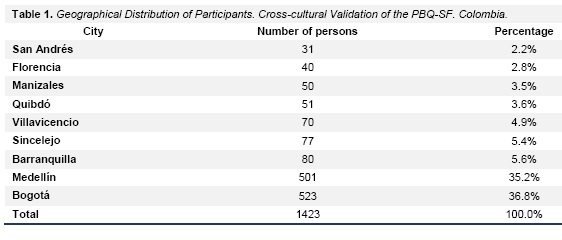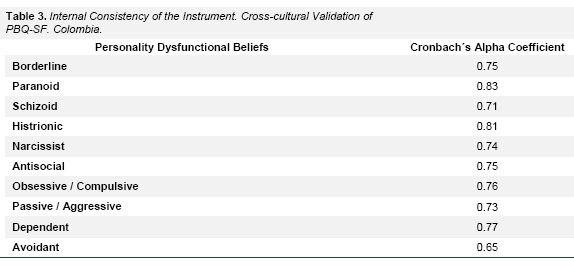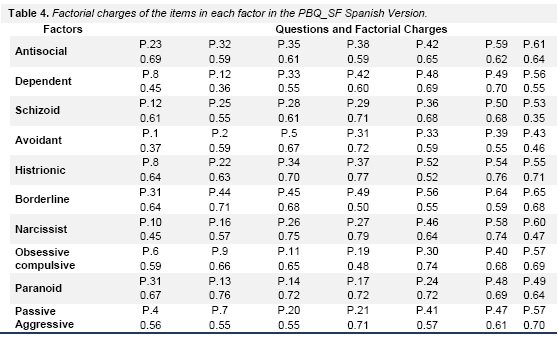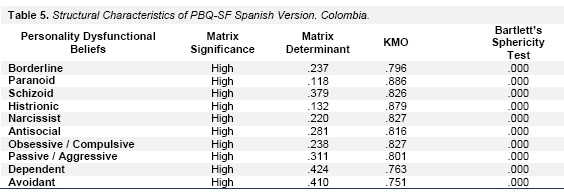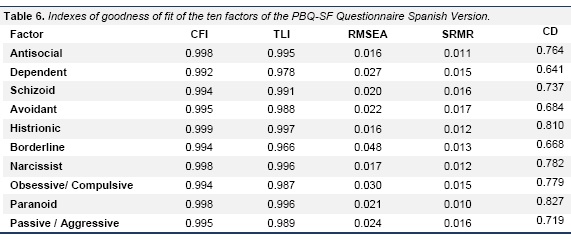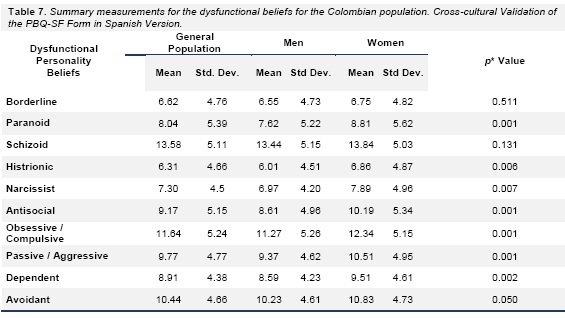Servicios Personalizados
Revista
Articulo
Indicadores
-
 Citado por SciELO
Citado por SciELO -
 Accesos
Accesos
Links relacionados
-
 Citado por Google
Citado por Google -
 Similares en
SciELO
Similares en
SciELO -
 Similares en Google
Similares en Google
Compartir
International Journal of Psychological Research
versión impresa ISSN 2011-2084
int.j.psychol.res. vol.8 no.2 Medellín jul./dic. 2015
Psychometric Properties and Structural Validity of the Short Version of the Personality Beliefs Questionnaire (PBQ-SF)
Propiedades Psicométricas y Validez Estructural de la Versión Corta del Cuestionario de Creencias de Personalidad (PBQ-SF)
Rubén Darío Manrique Hernándeza,* and Nadia Semenova Moratto Vasquezb
a Epidemiology and Biostatistics Research Group. Universidad CES. Medellin, Colombia.
b Psychology, Health and Society Research Group Universidad CES. Medellin, Colombia.
* Correspondence: Rubén Darío Manrique Hernández. Universidad CES. Calle 10 A # 22-04, Medellín, Colombia. E-mail: rmanrique@ces.edu.co.
Article history: Received: 24-03-2015 Revised: 03-06-2015 Accepted: 30-06-2015
ABSTRACT
The Personality Belief Questionnaire- Short Form (PBQ-SF) is an assessment instrument of personality beliefs based on the cognitive theory that states that these are characterized by a specific pattern of dysfunctional thoughts. The objective of this study was to establish the psychometric properties and structural validity of the PBQ-SF questionnaire in Colombian adults from 18 to 35 years old. To carry out the above and with permission of the author the validation process was initiated following a thorough and rigorous process that led to a final version of the PBQ-SF applied to 1423 persons born in Colombia and living in nine Colombian cities. Analysis of internal consistency among the items (Cronbach´s alpha), confirmatory factor analysis and calculus of goodness of fit estimators were performed. It was found that the Internal consistency of the domains varied from 0,65 for avoidant disorder up to 0,83 for paranoid disorder.
RESUMEN
El Cuestionario de Creencias de Personalidad - Versión Corta (PBQ-SF) es un instrumento de evaluación de creencias de personalidad basado en la teoría cognitiva que sostiene que estas están caracterizadas por un patrón específico de pensamientos disfuncionales. El objetivo de este estudio fue establecer las propiedades psicométricas y la validez estructural del cuestionario PBQ-SF, en adultos colombianos de 18 a 35 años. Para llevar a cabo lo anterior y con previa autorización del autor se inició el proceso de validación el cual siguió un proceso completo y riguroso que derivó en una versión final del PBQ-SF aplicada en 1423 personas nacidas en Colombia y residentes en 9 ciudades colombianas; se realizaron análisis de consistencia interna entre los ítems (alfa de Cronbach), análisis factorial confirmatorio y cálculo de los estimadores de bondad de ajuste. Se encontró que la consistencia interna de los dominios varió desde 0,65 para el trastorno evitativo hasta 0,83 para el trastorno paranoide.
Palabras clave: Personalidad, Creencias, Adaptación y Validación, PBQ-SF.
1. INTRODUCTION
The cognitive theory of personality disorders states that each personality disorder is characterized by a specific pattern of dysfunctional thoughts. Meanwhile, the Cognitive Profile concept is resumed from the Cognitive Therapy Model of Aaron Beck, to describe the cognitive style of people with clinical and personality disorders. The cognitive style is the way, mode or tendency to think and process information, to interact with the environment and himself.
The identification of a specific profile disorder for each of the disorders is based on the assumption of specificity of the schematic contents, which refers that each psychological disorder has a distinctive, cognitive profile, which is obvious at the level of schemes, of biased processing and automatic negative thoughts. Thus, it can be said, that the thought content of each disorder is specific and its identification facilitates the intervention process at the level of mental health (Beck, & Clark, 1997). In relation to personality disorders, Beck and Freeman (1995) consider that they are not characterized only for a dysfunctional or asocial behavior, but also for a constellation of beliefs and attitudes, feelings and strategies. It is possible to give a distinctive disorder profile based on cognitive, affective and behavioral traits. Please notice that the individuals may exhibit traits of more than one type of personality. Certain hypertrophied strategies may originate or compensate a specific type of self-concept and be a response to specific experiences of development. In addition, the genetic predisposition favors the development of a specific type of preference pattern to other possibilities.
According to the previous statement, Beck and Beck (1991) developed a self-report questionnaire to identify the dysfunctional beliefs related to each of the nine personality disorders described in DSM III R, since for Beck it is important to count with measurements of self-report, as a complement to the interviews based on beliefs (Beck et al, 2001). The PBQ was developed as an instrument for clinical and research use that measures dysfunctional beliefs associated with personality disorders, from 126 items (9 scales, 14 items per scale) (Butler, Beck & Cohen, 2007).
Trull, Goodwin, Schopp, Hillenbrand and Schuster (1993), obtained the psychometric properties from an early version of PBQ, which was applied to university students examining inter-correlations between the scales, as well as the correlations between the scales and other personality disorder measurements, finding an adequate evidence of reliability. The average correlation between the scales of PBQ was 0.40 and there was only a slight correlation between the PBQ and the revised questionnaire of personality disorders (Hyler et al., 1992) and the MMPI-PD (Morey, Waugh & Blashfield, 1985).
Two problems were found when interpreting the results of Trull et al. (1993). First, the PBQ was designed to be used with psychiatric patients and its validity criteria should be evaluated regarding general population. Second, it was suggested that the correlations between scales showed greater overlapping between the constructs that were being measured and affected the validity of the scales. This relates to the fact that it is difficult to find "pure" personality disorders and the common thing is to find heterogeneity in them. (Millon & Davis, 1996).
Beck, Butler, Brown, Dahlsgaard, Newman and Beck (2001), evaluated whether specific subscales of dysfunctional beliefs were differentially associated with five personality disorders. For these 756 psychiatric outpatients who completed the Personality Belief Questionnaire (PBQ) upon entry. Then, they were evaluated to identify in them personality disorders using a standardized clinical interview conducted by professionals who had no knowledge of the patient´s answers in the previous application of PBQ. The conclusions showed that patients with avoidant, dependent, obsessive-compulsive, narcissist and paranoid personality disorders, preferred the beliefs that theoretically are linked to the PBQ of their specific personality disorder. Expanding the results in this study was found a good consistency and high reliability in each of the PBQ scales. These results were repeated likewise in the research of Arntz et al. (1999) in which patients with personality disorders were compared with healthy controls.
Later a short form of this instrument was developed, which was done in two stages. In the first stage, data of patients that attended in outpatient psychiatric consultation that had completed the questionnaire between 1995 and 2001. The sample consisted of 920 persons, with an average age of 36.4 years (DT 11.1; range 18-76), of which 55% were women. In this sample, there was enough number of patients with personality disorders to validate five PBQ subscales: avoidant, dependent, obsessive-compulsive, narcissist and paranoid. A structured clinical interview by clinical personnel was done for the personality disorders (SCID-II). They were trained for at least two weeks before starting the evaluation. Seven items of each subscale that were more representative were identified and these were used to design the short form of this questionnaire and a multivariate analysis of the variance (MANOVA) was conducted to observe the interaction of gender, which was not significant ( Butler, Beck & Cohen, 2007). The reliability indexes for the subscales were avoidant (0.84), dependent (0.89), passive-aggressive (0.86), obsessive-compulsive (0.90), antisocial (0.80), narcissist (0.83), histrionic (0.89), schizoid (0.79) and paranoid (0.91). Besides, it was found that 85% of the 25 patients with personality disorders obtained a higher score in the subscale of the same disorder than in the other subscales or in none of the same test (Butler, Beck & Cohen, 2007). In the second stage, this version was applied to another sample of psychiatric outpatients and the internal consistency, the reliability - retest and the construct validity were evaluated. Patients who sought treatment at the Beck Institute of Cognitive Therapy and Research during 2003 and 2004 were evaluated. The sample consisted of 160 patients, of whom 58% were women, with an average age of 39.8 years (DT 14.2 years). In the sample the distribution Axis I disorders were: 53% with affective disorders, 28% with anxiety disorders, 10% with adjustment disorders and 9% with other disorders. Thirty-one patients had personality disorders, among these 9 had avoidant personality disorder, 7 obsessive- compulsive personality disorders, 7 borderline personality disorder and 26 non-specified personality disorders. (Butler, Beck & Cohen, 2007).
To the patients were applied the Depression Inventory of Beck II (Beck, Steer & Brown, 1996), the Beck Anxiety Scale (Beck & Steer, 1990), the Dysfunctional Attitude Scale (Weissman & Beck, 1978), the Rosenberg Self-esteem scale (Rosenberg, 1978), the Social Support Scale (Russell & Cutrona, 1984) and a scale to measure the psychosocial performance (Progress Assessment Scales, Ihilevich & Gleser, 1979, 1982). Besides, they were also interviewed using the SCID to diagnose disorders of axis I and axis II. The results of this study showed an alpha coefficient of 0.97. The total average of the scale was 81.28 (DT = 42.70). The subscales of PBQ-SF obtained alpha between 0.81, for narcissist and avoidant personality disorder, up to 0.92 of paranoid scale. The correlations test and retest were: avoidant 0.67, dependent 0.80, passive-aggressive 0.80, obsessive-compulsive 0.82, antisocial 0.57, narcissist 0.74, histrionic 0.78, schizoid 0.74 and paranoid 0.72 (Butler, Beck & Cohen, 2007).
All scales showed correlation with depression. Seven of the nine disorders showed correlation with anxiety, only the antisocial and narcissist scale did not have it. Depression and anxiety have a strong correlation with the dependency scale and show a weaker correlation with the narcissist scale. (Butler, Beck & Cohen, 2007).
Over time, PBQ has become an evaluation instrument for personality disorders. This is evident in studies such as in Jones, Burrell-Hodgson y Tate (2007), who conducted a research in which they measured PBQ ability to identify individuals with personality disorder, according to the scores obtained by them in the Million Multi-axial Personality Inventory (MCMI III). The study was conducted with 155 patients who were treated by clinical psychologists, for anxiety or depression problems, none of which had been referred for personality disorder treatment. The results of the research permitted to evaluate the avoidant, dependent, passive-aggressive and schizoid sub-scales, finding that each personality disorder could be predicted from the PBQ subscale.
Even though at the beginning, items in the PBQ had not been specially developed for the borderline personality disorder, Butler et al (2002) found 14 items that were significantly more appropriate for the borderline personality disorder than for any other disorder. These beliefs reflect the central topics of this disorder according to the cognitive therapy: dependency and distrust beliefs.
Therefore, Bhar, Brown and Beck (2008), conducted a study that sought to examine the structure for the subscale for borderline personality disorder of PBQ. The study was carried out with 184 patients, with an average age of 33.1 years (range 18-61; SD 10.47) diagnosed with Borderline Personality Disorder, who had been evaluated for psychotic disorders. 97.3% of these had comorbidity with Axis I disorders and 84.2% had a mood disorder. They also found that 46.4% had comorbidity with other personality disorders. The results of the study showed three factors: the feeling of being defenseless, without the constant support of others, expectations of being betrayed by others or dishonesty and vision that one must preventively avoid threat. Although the three factors related with depression, only dependence and mistrust were associated with hopelessness. Distrust was the factor more related with suicide conception. These results support the dimensional structure of the borderline personality subscale of PBQ.
As can be seen, the consistency of PBQ in relation with evaluating dysfunctional beliefs of personality disorders was successful; however, the study of McMurran and Christopher (2008) shows a different evidence. These researchers conducted a study that sought to confirm the Beck et al (2001) research in which correlations between the PBQ subscales and the personality disorders were found, but in which the histrionic, schizoid and antisocial scales could not be analyzed, due to an insufficient number of patients. The participants were 71 male inmates of three prisons, with an average age of 33 years (SD = 8.03), to whom the International Interview of Personality Disorder (IPDE) and the PBQ were applied. Of the total sample of 31 prisoners, (43.67%) had a diagnosis and 12 prisoners (16.90%) had a probable diagnosis. The results of this research did not show that the antisocial beliefs subscale discriminated against those that had antisocial personality disorder from those without. Looking at the content of this scale we find that the items are focused on selfishness and "trying to be number one" despite the impact on others and how the others see the subject. In this study, these beliefs did not discriminate men with antisocial personality disorders. (McMurran & Christopher, 2008).
According to the above, the validation of PBQ in an American context has been sufficiently evaluated; showing with it, not only effectiveness when it is was used in assessing the patient but usefulness in intervention process with patients. This suggests the need to carry out a validation process that permits to run the test in the Colombian context. Even if in previous years it included a validation of by Londoño, Calvete and Palacio (2012) they also noticed limitations in the validation process with reference to the (non-random) sampling type, non-homogeneous distribution of the different categories of the socio-demographic variables (city, age group, occupation, educational level) and a concentration of the sample in a specific age (17 years). Therefore, to think in a new validation, that takes into account these limitations permits to emphasize the purpose of the current research, where much emphasis is made in the use of validated and standardized instruments to comply with the methodological requirements for this. This increases the certainty that the instrument has to measure what it has to be measured and at the same time complies with the measurement principle that states that regardless of whether an instrument has been validated in some context, it does not mean that is valid in another time, culture or context. (Gjersing, Caplehorn & Clausen, 2010).
Currently there is no universal agreement on how to adapt the instruments to another culture, but we do know that it is not simply to make a translation, but that it implies an adaptation from the linguistic aspect, but also including the verification of validity and reliability. This process is important when an instrument is to be used in another language, moment or time, to reduce the risk of bias in the study; especially when what is going to be measured are attitudes, which cannot be directly observed, but are inferred by the answers in a questionnaire. (Gjersing, Caplehorn & Clausen, 2010).
All this then led to carry out the study that not only pretends a validation of a test, but adapting the same to the context, in such a way that it can be used in the clinical and research field.
2. METHOD
This study is due to a quantitative bet, correlational of structural and concurrent validation and determination of the psychometric properties of the Personality Belief Questionnaire Short Form (PBQ-SF) in Colombian population.
2.1 Population and Sample
The reference population were the persons of both genders, between 18 and 35 years old, born in Colombia and living in nine different cities of Colombia (San Andrés, Florencia, Manizales, Quibdó, Villavicencio, Sincelejo, Barranquilla, Medellín and Bogotá).
Since this study is linked to a doctoral thesis that aims to evaluate the personality beliefs in offending drivers, the range of age defined for the study population was due to the fact that the driver's licenses are requested by 85% of people with this gender and age characteristics. With regard to the selection of cities, at the beginning Medellín was chosen to host the Doctoral study and through a random selection was formed the group of cities, taking as criteria to include at least one city in each geographical region of the country.
This study tended for an ample and heterogeneous sample, so that it was representative, both in number and participants of the general population. When small samples are used there is the risk of finding correlations proper of the sample or that do not show all the diversity of the population participants. Some studies have used samples that vary between 700 (Beck, Butler, Brown, Dahlsgaard, Newman & Beck, 2001) and 950 (Butler, Beck & Cohen, 2007) persons randomly selected from the target population of the study. According to the above, the random type sample used in this Project component was not less than 900 persons, men and women of this age range.
The factor analysis was used as estimation criteria for the size of the sample. To perform the factor analysis of the instrument, that has 65 questions, a fraction of the sample was applied among 8 to 10 participants per question, to reach between 80% and 100% of reliability, which suggested a sample of 650 persons. Since the instrument was applied in nine cities the greater fraction of sampling was used with a design effect of two, therefore, the total estimated sample was 1260 persons.
Adding to the supposition that a maximum of 20% of the participants (1 in 5 persons) had not properly filled out the instrument, specifically that they had not completed it or had left some question without answer, the final size of the sample was 1575 persons. However, the final number of participants on which valid information was obtained for carrying out the analysis was 1423 persons, surpassing the total estimated in the sampling design. Finally, the number of participants per city was estimated with a proportional fixation according to the population figures between 16 and 35 years of age in each city.
2.2 Validation Process
To carry out the validation process the following steps were taken:
- The test was acquired and the authorization from the test´s authors, Aaron Beck y Judith Beck of Beck Institute of the United States was obtained to carry out the validation process of the test in Colombia.
- A Spanish translation is performed by two independent translators and they were isolated from one another. The translated Spanish versions were reviewed by an expert committee on the topic and the methodology of test validation chose the best version.
- Then, the most adequate version was defined; it was retranslated into English by other two qualified persons, in an independent and isolated way. None of these translators knew the original version of the instrument.
- The consolidated retranslation version was submitted, along with the Spanish version, to professor Aaron Beck, creator of the test. With author´s recommendations, who gave a favorable concept on the quality and the similitude of the translations, we proceeded to consolidate the final version translated into Spanish of the PBQ-SF.
- Pilot test: The instrument was tested with a group of 325 persons, randomly selected, in order to refine the design aspects and the form details, but not the background in the wording of the questions. The test was applied by professionals in psychology trained and standardized by the researchers on the structure, content and application form of the instrument. With the results obtained in the pilot test, adjustments were done in the presentation of the instrument.
- The formal application of the instrument was carried out in the sample designed for purpose. Psychologists of the nine cities included were trained in the sampling design, who carried out the process during an average of four months until all the samples in each city were completed.
- Reliability and validity of the construct was evaluated, by estimating the internal consistency indexes (Cronbach´s alpha) and confirmatory factor analysis.
- Other statistics tests as the significance of correlation matrix, the Kaiser-Meyer-Olkin test and the Bartlett´s sphericity test were carried out to verify the structural validity of the scales that make up the PBQ-SF.
3. RESULTS
3.1 Socio-demographic Variables
1423 instruments were applied of the Spanish translated version of PBQ-SF, in nine Colombian cities randomly selected. The number of people interviewed in each city was calculated by proportional fixation to the number of inhabitants from 18 to 35 years in each selected city. (Table 1)
Table 2 shows that the participants were 896 men (63%) and 527 women (37%). 95% (n=1340) of the participants reported as being single. The majority (66.4%) reported to have university studies, undergraduate or postgraduate, and a quarter of the sample reported having followed up to high school.
3.2 Evaluation of internal consistency of the instrument Personality Beliefs.
Cronbach´s alpha coefficient was calculated to verify reliability (internal consistency) of each of the ten factors in the selected sample. This index was calculated for the total scale. In the following Table, the results of internal consistency of each of the factors analyzed were shown. All the values of Cronbach´s coefficient above 0.60, which allow us to interpret them as adequate. Cronbach´s alpha statistics had a value of 0.93 for the total PBQ-SF scale translated to Spanish, a value highly significant, reflecting the internal consistency of the items that comprise it to value the existence of personality dysfunctional beliefs.
From its design, the Personality Beliefs Questionnaire (PBQ-SF), given the high internal consistency of its factorial components, each of which represent a personality dysfunctional belief, allows the use of the subscales independently for the evaluation of these factors in a specific interest groups. Thus, for example, components of borderline type dysfunctional beliefs, narcissist, histrionic and antisocial, can be used for the measurement of such characteristics in persons with this type of associated behaviors, such as impulsivity, hostility, aggression and the search of sensations. (Table 3)
3.3 Confirmatory Factor Analysis
Prior to carrying out the confirmatory factor analysis the factorial charges in each of the 10 proposed indicators were analyzed. As may be seen in table 4, in each of the items, the factor previously defined charged more, confirming with that that all the items were well explained from the theoretical construct for which they were defined.
3.4 Confirmatory Factor Analysis Results
Statistics tests as the significance of the correlation matrix, the evaluation of the determinant of the correlation matrix, the Kaiser-Meyer-Olkin test and Bartlett´s sphericity test were used to verify the structural validity of the scales that make up the PBQ-SF. (See Table 5)
A matrix determinant of relatively low correlations identified, except avoidant and dependent factors, thus indicating that the variables held by each evaluation category of (PBQ-SF) test are linearly related.
Similarly, it was evident an appropriate factor model in each of the categories (scales) of evaluation of PBQ SF questionnaire Spanish Version, since the results obtained by measuring the sampling adequacy of Kaiser-Meyer-Olkin (Coefficient KMO) were close to 1; among the highest identified factor is the paranoid factor (0.886) and the histrionic (0.879). Since all the items show values above 0.50 with the indicator KMO we conclude that the factor analysis is highly suitable as an analysis model for these scales. This result is consistent with the significance level of the Bartlett´s sphericity test, for which all the resulting items also are highly significant. Finally, the analysis of the quadratic saturations derived from the extraction of the main components of the instrument showed a total variance explained of the 55.2 %, percentage that may be considered acceptable. (See Table 6)
To evaluate the adjustment of the model were used: the Root Mean Square Error of Approximation (RMSEA) and the Standardized Root Mean Square Residual (SRMR) as absolute adjustment measurements and the Tucker-Lewis Index (TLI) and Comparative Fit Index (CFI) as incremental adjustment measurements. (Gelabert et al., 2011; Leighton, Gokiert y Cui, 2007), besides the coefficient of determination CD was estimated. With respect to this pointed out that adequate level of a good adjustment of the model is a RMSEA less than .08 (MacCallum, Browne & Sugawara, 1996), reaching a good adjustment for values below .06 (Hu & Bentler, 1999) and a strict superior borderline of .07 (Steiger, 2007), as we found in this study. For the measurements TLI and CFI, greater or equal values to .90 are indicative of an adequate adjustment (Bentler & Bonnet, 1980). These type of values were found in this study. Each of the factors referred to in the questionnaire; obtain adequate values for the different indicators, showing acceptable adjustment levels for the data; in the same way all, the parameters were significant. The coefficient of determination CD indicated a high explicative value of the questions in each one of the factors. This permits to suppose that the questions tend to explain sufficiently the behavior of each of the factors in general. The results show that using the confirmatory factor analysis the factorial solutions obtained are valid.
To establish if there were significant differences in the dysfunctional personality beliefs between men and women and since the test values refer to a numerical scale, and not to quantitative variables, the non-parametric Mann-Withney U test was used. With exception of the borderline type and schizoid type personality beliefs, the others were significantly different between men and women. Even though there is a controversy about the dysfunctional personality beliefs if they are associated or not to gender, these findings should be taken into account at the moment of interpreting the results of applying the PBQ-SF test.
4. DISCUSSION
For the validation process of the psychometric instruments you must have selection, application and design techniques of a rigorous scheme of data quality control, all of that in order to determine and back up the metric properties of the instruments, in our case the PBQ-SF. Similarly, as a backup of this process, it was necessary to count with a rigorous theoretical planning and an appropriate methodological design.
According to this, during this process, the generation of evidence of construct validity as a validation stage was carried out with rigor and therefore the results lead to the conclusion that the said questionnaire effectively gives account of the interest traits under the appropriate dimensions according to the Beckian theory that oriented its initial design and posterior sustenance. It is important to point out that this research process intended to establish the psychometric properties of an instrument that evaluates the personality beliefs and is not centered in the clinical diagnosis of personality disorder, which was taken into account in the selection process the sample, which corresponded to a non-clinical population.
With respect to the confirmatory factor analysis (CFA), this constitutes one of the analysis procedures more used in research, since it emphasizes the study of the relationship between the a set of variables observed and one or more factors, for the case, the items of a test, specifically the PBQ-SF and the scores obtained by the subjects in Colombia. The confirmatory factor analysis is, in consequence, a very useful strategy in the scope of the hypothesis test and the confirmation in the PBQ-SF of the Beckian theory.
It is considered that although there are different forms of measuring of possible adjustment indexes, none of them separately is enough to determine that the model adjusts to the data. The most used combination today is the following: χ2, RMSEA, ECVI, SRMR, GFI and CFI: this set should be sufficient to take a decision with respect to the adjustment of the model (Boomsna, 2000; McDonald & Ho, 2002). Based on the above, it is evident in the validation process that the conjugation of these measurements shows an appropriate structural validity and suggests it potential application with reduced uncertainties.
Therefore, it is concluded that the questionnaire of personality beliefs (Personality Belief Questionnaire PBQ-SF) of Aaron Beck and Judith Beck, contains 10 scales that may be applied in an independent or joint form to measure each one of the personality beliefs, of the disorders described in the Diagnosis and Statistics Handbook of Mental Illness DSM V: avoidant, dependency, passive-aggressive, obsessive-compulsive, antisocial, narcissist, histrionic, schizoid and paranoid.
The Instrument PBQ-SF, has high stability and internal consistency indexes, which Cronbach´s alpha values go from 0.65 in the avoidant disorder up to 0.83 in the paranoid disorder; values of high acceptability at the moment of considering the reliability of a scale and as in the Londoño, Calvete and Palacio (2012) study they oscillated between 0, 68 and 0,84. Besides, it showed consistency and agreement with the validation studies for other countries and when its effectiveness was compared with other instruments of the same type (Jones, Burrell-Hodgson, Tate, 2007) and other scales or evaporative criteria of personality (Beck, Butler, Brown, Dahlsgaard, Newman, Beck, 2001).
The agreement of the findings around validity and reliability of this instrument in relation to the values originally reported by the research team of the Beck Institute, permit to conclude that the PBQ-SF questionnaire validated for Colombia, in its Spanish version, is a psychological evaluation tool that may be used in different non-clinical scopes to identify personality dysfunction beliefs in populations groups who are interested in establishing association relations between these and other behaviors for example: aggressiveness, impulsivity, search of sensations among others; which mean risk of occurrence of deathly outcomes for the individual or collective health.
5. REFERENCES
Arntz, A., Dietzel, R., & Dreessen, L. (1999). Assumptions in borderline personality disorder: specificity, stability and relationship with etiological factors. Behaviour Research and Therapy, 37, 545-557. [ Links ]
Beck A.T, Butler AC, Brown GK, Dahlsgaard KK, Newman CF & Beck JS (2001). Dysfunctional beliefs discriminate personality disorders. Behavioral Research Therapy. 39(10):1213-1225. [ Links ]
Beck, A. T. & Steer, R.A. (1990).Manual for the Beck Anxiety Inventory. San Antonio, TX: Psychological Corporation. [ Links ]
Beck AT & Beck JS (1991). The Personality Belief Questionnaire. Unpublished assessment instrument. Bala Cynwyd, PA: The Beck Institute for Cognitive Therapy and Research. [ Links ]
Beck, AT & Freeman, A (1995). Terapia Cognitiva de los Trastornos de la Personalidad. Buenos Aires: Paidós. [ Links ]
Beck, AT, Freeman A, Davis D, et al. (2004). Cognitive Therapy of Personality Disorders. Second Edition. New York: The Guilford press. [ Links ]
Beck, J. (2005). Cognitive Therapy for Challenging Problems. What to do when the Basic dont work. New York: Guilford Press. [ Links ]
Beck, J. (1995). Terapia Cognitiva. Conceptos básicos y profundización. España: Gedisa. [ Links ]
Beck, JS (1996). Cognitive therapy of personality disorders. In P. A. Salkovskis, Frontiers of Cognitive Therapy (pp. 165-181). New York: Guilford Press. [ Links ]
Beck, JS (1998). Complex cognitive therapy treatment for personality disorder patients. Bulletin of the Menninger Clinic, 62 (2), 170-194. [ Links ]
Bentler, P. M., & Bonnet, D. C. (1980). Significance Tests and Goodness of Fit in the Analysis of Covariance Structures. Psychological Bulletin, 88 (3), 588-606. [ Links ]
Beck, A. T., & Clark, D. A. (1997). An information processing model of anxiety: Automatic and strategic processes. Behaviour Research and Therapy, 35, 49-58. [ Links ]
Bhar SS, Brown GK & Beck AT (2008). Disfunctional beliefs and psychopathology in borderline personality disorder. Journal of personality disorders. 22(2): 165 - 177. [ Links ]
Boomsma, A. (2000). Reporting analyses of covariance structures. Structural Equation Modeling: A Multidisciplinary Journal, 7,461-483. [ Links ]
Butler. A C., Brown, G. K. Beck. A. T. & Grisham, J. R. (2002). Assessment of dysfunctional beliefs in borderline personality disorder. Behaviour Research & Therapy. 40.1231-1240. [ Links ]
Butler AC, Beck AT & Cohen LH (2007). The personality Belief Questionnaire - Short Form: Development and Preliminary Findings. Cognitive Therapy Research. 31: 357-370. [ Links ]
Gelabert, E. (2011). Psychometric properties of the Spanish version of the Frost Multidimensional Perfectionism Scale in women, Psicothema, ISSN: 1886-144X. 23(1), 133-139. [ Links ]
Gjersing L, Caplehorn JRM & Clausen T (2010). Cross-cultural adaptation of research instruments: language, setting, time and statistical considerations. BMC Medical Research Methodology. 10:13. [ Links ]
Hu, L.-t., & Bentler, P. M. (1999). Cutoff Criteria for Fit Indexes in Covariance Structure Analysis: Conventional Criteria versus New Alternatives. Structural Equation Modeling, 6 (1), 1-55. [ Links ]
Hyler, S., Reider, R., Williams, J. (1987). Personality Diagnostique Questionnaire Revised (PDQ-R). New York: New York State Psychiatric Institute. [ Links ]
Hyler, S. E., Skodol, A. E., Oldham, J. M., Kellman, H. D., & Doidge, N. (1992). Validity of the Personality Diagnostic Questionnaire-Revised: A replication in an outpatient sample. Comprehensive Psychiatry, 33, 73-77. [ Links ]
Jones SH, Burrell-Hodgson G, Tate G. (2007). Relationships between the personality beliefs questionnaire and self-rated personality disorders. British Journal Clinical Psychology. 46(Pt 2): 247-251. [ Links ]
Kernberg OF (1996). A psychoanalytic theory of personality disorders. In J. F. Clarkin, (Eds.), Major theories of personality disorder. New York: Guilford. [ Links ]
Leighton, J. P., Gokiert, R.J., & Cui, Y. (2007). Using exploratory and confirmatory methods to identify the cognitive dimensions in a large-scale science assessment. International Journal of Testing, 7, 1-49 [ Links ]
Ihilevich, D. & Glesser, G. C. (1979). A Manual for the Progress Evaluation Scales, Shiawasse, MI: Community Mental Health Services Board. [ Links ]
Londoño, N. H., Calvete, E., & Palacio, J. (2012). Validación del "Cuestionario de creencias de personalidad-versión breve"(PBQ-SF) en población no clínica colombiana. Psicología Conductual, 20(2), 305. [ Links ]
MacCallum, R. C., Browne, M. W., & Sugawara, H. M. (1996). Power Analysis and Determination of Sample Size for Covariance Structure Modeling. Psychological Methods, 1(2), 130-149. [ Links ]
McDonald, R. P., & Ho, M. R. (2002). Principles and practice in reporting structural equation analyses. Psychological Methods, 7, 64-82. [ Links ]
McMurran M & Christopher G (2008). Dysfunctional beliefs and antisocial personality disorder. The journal of forensic psychiatry & psychology. 19 (84), 533 - 542. [ Links ]
Millon, T. (1997). Millon Clinical Multiaxial Inventory III (MCMI III). 2nd ed. Minneapolis, MN: National Computers Systems. [ Links ]
Millon T & Davis R (1996). An evolutionary theory of personality disorders. In J. F. Clarkin, & M. F. Lenzenweger, Major Theories of Personality Disorder (pp. 221-246). New York: Guilford Press. [ Links ]
Millon, T. & Millon, C. (1997). History, Theory and validation of the MCMI. En: T. Millon (ed). The Millon Inventories. Clinical and personality Assessment (cap 2). New York: The Guilford Press. [ Links ]
Millon, T. y Davis, R. (1998). Trastornos de la personalidad: más allá del DSM-IV. Barcelona: Masson. [ Links ]
Morey, L. C., Waugh, M. H., & Blashfield, R. K. (1985). MMPI scores for the DSM-III personality disorders: Their personality disorders. In J. F. Clarkin, & M. F. Lenzenweger, Major Theories of Personality Disorder (pp. 347- 390). New York: Guilford Press. [ Links ]
Rosenberg, M., & Rosenberg, Fr. (1978). Self esteem and delinquency. Journal of Youth and Adolescence, 7(3), 279-291. [ Links ]
Russell, D., Cutrona, C.E., Rose, J., & Yurko, K. (1984). Social and emotional loneliness: An examination of Weiss's typology of loneliness. Journal of Personality and Social Psychology, 46, 1313-1321. [ Links ]
Steiger, J. H. (2007). Understanding the limitations of global fi t assessment in structural equation modeling. Personality and Individual Differences, 42 (5), 893-898. [ Links ]
Trull, T. J., Goodwin, A. H., Schopp, L. H., Hillenbrand, T. L., & Schuster, T. (1993). Psychometric properties of a cognitive measure of personality disorders. Journal of Personality Assessment, 61 (3), 536-546. [ Links ]
Weissman, A.N., & Beck, A.T. (1978). Development and validation of the dysfunctional attitude scale. Paper presented at the Annual meeting of the Association for the Advanced Behavior Therapy, Chicago. [ Links ]













